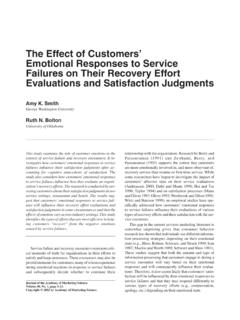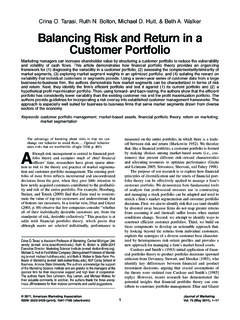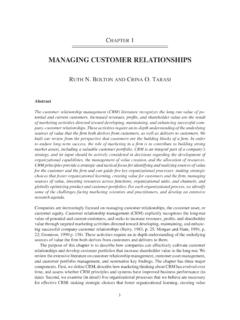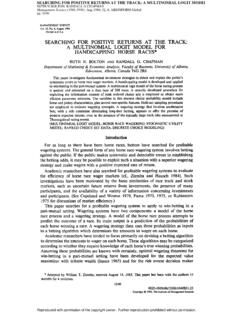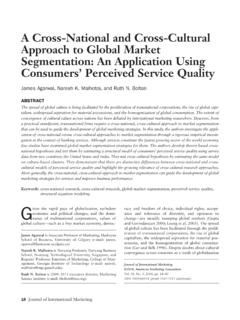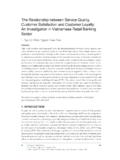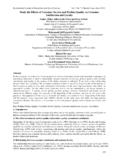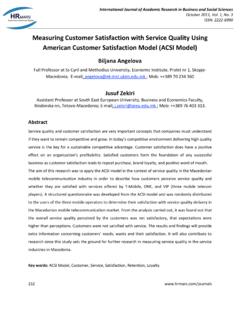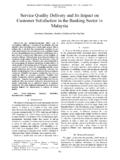Transcription of A Model of Customer Satisfaction with Service …
1 356 Journal of Marketing ResearchVol. XXXVI (August 1999), 356 372*Amy K. Smith is Assistant Professor of Marketing, George WashingtonUniversity (e-mail: Ruth N. Bolton is Ruby K. PowellProfessor of Marketing, Michael F. Price College of Business, University ofOklahoma (e-mail: Janet Wagner is AssociateProfessor of Marketing, The Robert H. Smith School of Business,University of Maryland (e-mail: The authorsgratefully acknowledge the financial support of the Marketing ScienceInstitute. To interact with colleagues on specific articles in this issue, see Feedback on the JMRWeb site at K.)))
2 SMITH, RUTH N. BOLTON, and JANET WAGNER*Customers often react strongly to Service failures, so it is critical that anorganization s recovery efforts be equally strong and effective. In this ar-ticle, the authors develop a Model of Customer Satisfaction with servicefailure/recovery encounters based on an exchange framework that inte-grates concepts from both the consumer Satisfaction and social justice lit-erature, using principles of resource exchange, mental accounting, andprospect theory. The research employs a mixed-design experiment, con-ducted using a survey method, in which customers evaluate various fail-ure/recovery scenarios and complete a questionnaire with respect to anorganization they recently had patronized.
3 The authors execute the re-search in the context of two different Service settings, restaurants and ho-tels. The results show that customers prefer to receive recovery resourcesthat match the type of failure they experience in amounts that arecommensurate with the magnitude of the failure that occurs. The findingscontribute to the understanding of theoretical principles that explain cus-tomer evaluations of Service failure/recovery encounters and providemanagers with useful guidelines for establishing the proper fit betweena Service failure and the recovery Model of Customer Satisfaction withService Encounters Involving Failure and RecoveryOrganizations are facing more intense Customer servicepressures than ever before.
4 When a Service failure occurs,the organization s response has the potential either to restorecustomer Satisfaction and reinforce loyalty or to exacerbatethe situation and drive the Customer to a competing recoveryrefers to the actions an organization takesin response to a Service failure (Gronroos 1988). Recoverymanagement is considered to have a significant impact oncustomer evaluations, because customers are usually moreemotionally involved in and observant of recovery servicethan in routine or first-time Service and are often more dis-satisfied by an organization s failure to recover than by theservice failure itself (Berry and Parasuraman 1991; Bitner,Booms, and Tetreault 1990).
5 Keaveney (1995) finds thatservice failures and failed recoveries are a leading cause ofcustomer switching behavior in Service , well-executed Service recoveries are importantfor enhancing Customer Satisfaction , building Customer rela-tionships, and preventing Customer defections (Fornell andWernerfelt 1987).Although Service recovery is recognized by researchersand managers as a critical element of Customer Service strat-egy, there are few theoretical or empirical studies of servicefailure and recovery issues. Studying Service recovery ischallenging because recovery is triggered by a Service fail-ure, making systematic empirical research difficult to con-duct in either a laboratory or a field environment.
6 Previousresearch on Service recovery has focused on developingclassification schemes (Bitner, Booms, and Tetreault 1990;Hoffman, Kelley, and Rotalsky 1995; Kelley, Hoffman, andDavis 1993) and providing correlational or anecdotal sup-port for the effect of Service recovery on Customer satisfac-tion (Kelly and Davis 1994; Spreng, Harrell, and Mackoy1995). Recently, Tax, Brown, and Chandrashekaran (1998)examined the influence of customers justice evaluations onsatisfaction, trust, and commitment after a Service complaintexperience. However, to date, no one has developed a theo-ry-driven Model of Customer Satisfaction with Service fail-Failure and Recovery357ure/recovery encounters that considers proactive recoverysituations, in which the organization initiates a recovery ef-fort, as well as reactive recovery situations, in which the cus-tomer s complaint initiates the recovery a recent review article, Rust and Metters (1996) calledfor interdisciplinary models of Customer behavior in servic-es marketing.
7 We present an exchange framework for ex-plaining Customer evaluations of Service failure/recovery ex-periences, drawing on behavioral principles of resourceexchange, prospect theory, and mental accounting. Fromthis framework, we derive a Model of Customer satisfactionwith Service failure/recovery encounters that includes threedimensions of perceived justice (a social exchange concept),as well as disconfirmation of expectations (a Customer satis-faction concept). The objectives of this research are to (1)develop and test a Model of Customer Satisfaction with serv-ice failure/recovery encounters, using an exchange frame-work; (2) determine the effects of various types of recoveryefforts on Customer evaluations in a variety of Service failurecontexts.
8 And (3) provide managers with guidelines for es-tablishing the proper fit between a Service failure and therecovery prior studies, our Model integrates perceived jus-tice and expectancy disconfirmation, investigates specificaspects of the Service failure and the recovery effort as an-tecedents to Customer evaluations, and includes proactiveand reactive recovery efforts. We treat Service recovery as a bundle of resources that an organization can employ in re-sponse to a failure. By treating recovery in this manner, weare able to examine the specific determinants of an effectiverecovery and the relative importance of individual recoveryattributes in restoring Customer Satisfaction across a varietyof Service failure conditions.
9 We use a mixed-design exper-iment, conducted by survey, in which customers evaluatevarious Service failure/recovery scenarios relative to an or-ganization they recently had patronized. This research isperformed in the context of two different Service settings,restaurants and FRAMEWORK AND MODELDEVELOPMENTIn the next three sections, we present a Model and a set ofhypotheses that describe the effects of Service recovery ef-forts in various failure contexts on customers perceptions ofjustice and judgments of Satisfaction . The Model provides aframework for considering how Service failure context (typeand magnitude) and Service recovery attributes (compensa-tion, response speed, apology, initiation) influence customerevaluations through disconfirmation and perceived justice,thereby influencing Satisfaction with the Service failure/re-covery encounter.
10 The hypotheses describe the effects ofperceived justice on Customer Satisfaction ; of recovery at-tributes on perceived justice; and of failure context, recoveryattributes, and their interaction on perceived of Perceived Justice and Disconfirmation onCustomer SatisfactionOliver and Swan (1989a, b) were first to Model the jointinfluence of disconfirmation and perceived justice on cus-tomer Satisfaction , but they address only one aspect of per-ceived justice, the distributive (equity) aspect. Because therole of disconfirmation is well known, we focus on the ef-1 This conceptualization was adapted from Bies and Moag (1986) and hasbeen applied to complaint handling episodes (Tax 1993; Tax, Brown, andChandrashekaran 1998).

